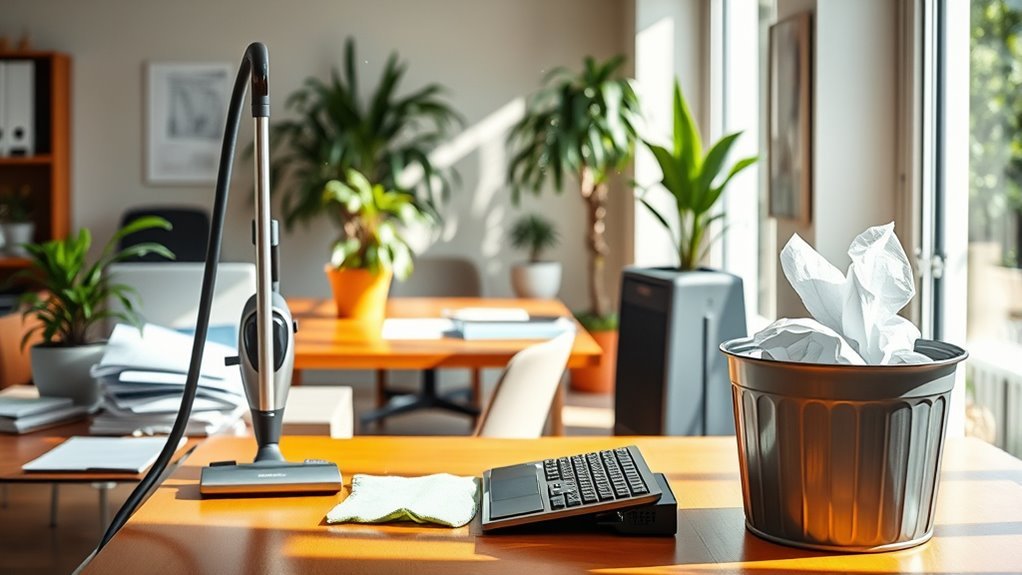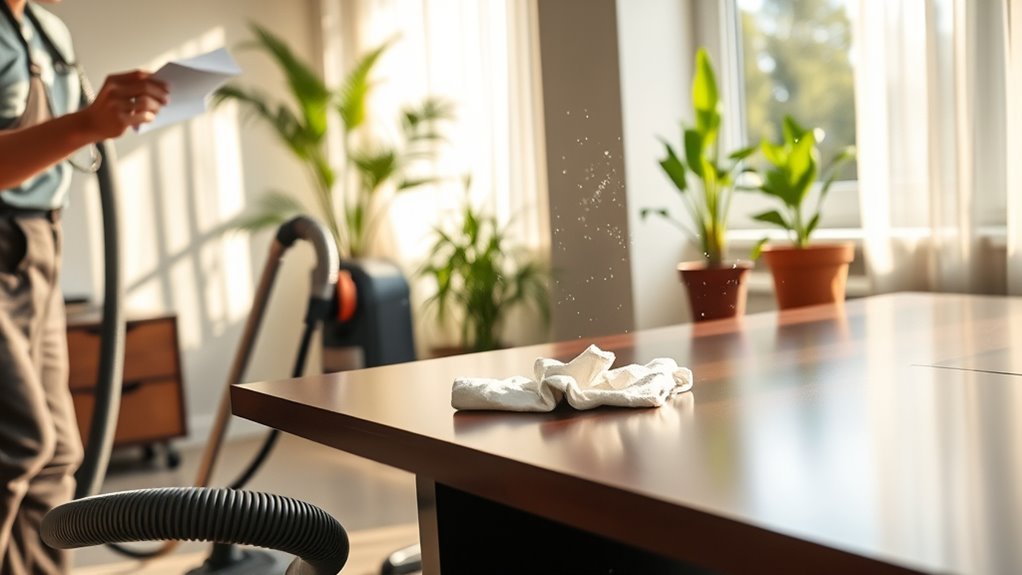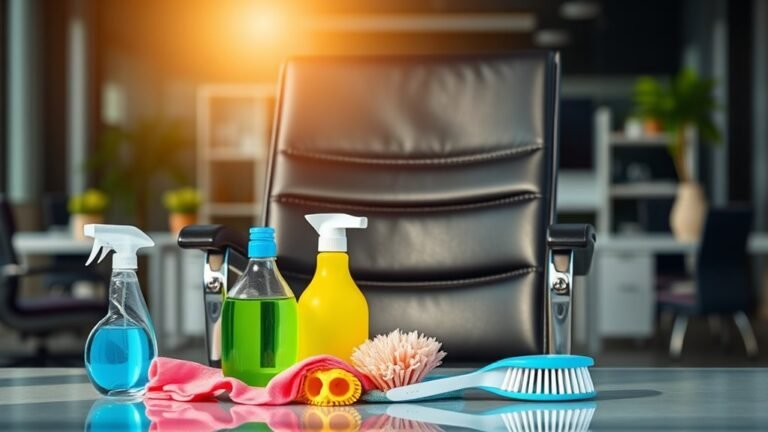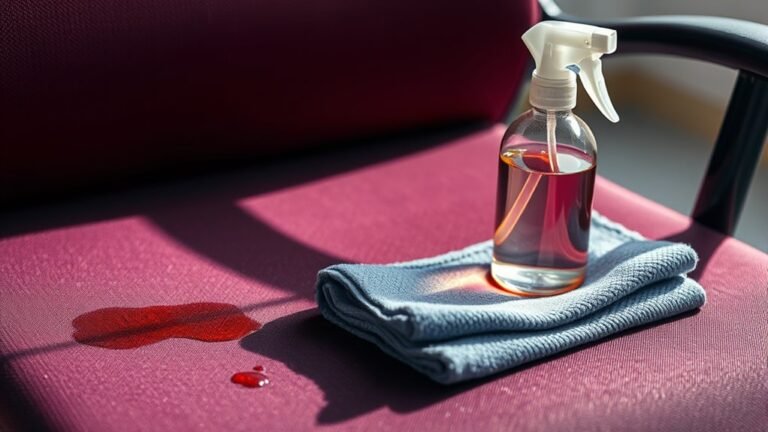How to Clean Allergens in Office Spaces
To clean allergens in your office, focus on dusting with microfiber cloths, vacuuming carpets and upholstery using HEPA-filter vacuums, and regularly cleaning HVAC filters and ducts. Control moisture to prevent mold, improve ventilation by increasing fresh air intake, and use HEPA air purifiers. Keep your workspace tidy and practice good hand hygiene. Managing pet dander with clear policies also helps. These steps create a healthier work environment, and there’s plenty more to explore for lasting allergen control.
Identify Common Allergens in Office Environments

Before you can effectively clean allergens in your office, you need to know what you’re dealing with. Common allergens in office environments often come from everyday office sources like dust mites hiding in carpets and upholstery, mold growing in damp corners, and pet dander brought in on clothing. You might also find pollen sneaking in through open windows or clinging to indoor plants. Don’t overlook office equipment either—printers and computers can collect dust that triggers allergies. Understanding these common allergens lets you target your cleaning efforts wisely, freeing yourself from sneezing fits and congestion while working. By identifying these sources, you take the first step toward creating a healthier, more liberating workspace where you can breathe easy and focus on what truly matters.
Optimize Air Quality With Proper Ventilation
To improve air quality in your office, start by evaluating your ventilation system to guarantee it’s working efficiently. You’ll also want to increase the intake of fresh air whenever possible to help reduce allergens. These steps can make a big difference in creating a cleaner, healthier workspace.
Assess Ventilation Systems
One of the most effective ways you can improve air quality in your office is by evaluating the ventilation systems. A thorough ventilation assessment helps you identify issues that restrict airflow and trap allergens inside. To guarantee system efficiency and keep your workspace fresh, focus on these key steps:
- Inspect air filters regularly and replace them when clogged to maintain clean airflow.
- Check for blockages or leaks in ducts that reduce ventilation performance.
- Test system controls and fans to confirm they operate smoothly and provide consistent air circulation.
Increase Fresh Air Intake
After ensuring your ventilation system is working properly, you can boost indoor air quality further by increasing the amount of fresh air brought into your office. Letting in more fresh air improves air circulation, helping to dilute and remove allergens that can trap you indoors. You don’t want to feel confined by stale, recycled air. Open windows when possible or adjust your HVAC settings to maximize outdoor air intake. Using fans strategically can also promote better air circulation, pushing fresh air through the space and keeping it moving. By increasing fresh air intake, you create a freer, healthier environment where allergens are less likely to accumulate. This simple step gives you control over your workspace atmosphere and lets you breathe easier every day.
Regular Dusting and Surface Cleaning Techniques

Although it might seem routine, regular dusting and surface cleaning play an essential role in reducing allergens in your office. When you stick to effective dusting techniques, you free yourself from lingering irritants. Keep in mind, different surface materials need specific care to avoid damage while ensuring cleanliness.
Here’s how to maintain allergen-free surfaces with ease:
- Use microfiber cloths—they trap dust better than traditional dusters and work well on wood, glass, and metal.
- Clean from top to bottom to prevent dust from resettling on already cleaned areas.
- Choose gentle, non-toxic cleaners suitable for your office’s surface materials to avoid chemical residues.
Effective Vacuuming Strategies for Carpets and Upholstery
You’ll want to pick a vacuum with strong suction and a HEPA filter to trap allergens effectively. When cleaning carpets and upholstery, use slow, overlapping strokes to guarantee you capture dust and debris. Don’t forget to vacuum regularly to keep allergen levels low in your office space.
Choosing the Right Vacuum
Choosing the right vacuum can make all the difference when it comes to removing allergens from carpets and upholstery. You want a vacuum with strong suction and HEPA filters to trap tiny particles that cause allergies. Don’t overlook vacuum features like adjustable height settings for different carpet types and attachments designed for upholstery. Keeping your vacuum in top shape is just as important—regular vacuum maintenance guarantees it performs effectively over time. Here are the essentials to take into account:
- Filtration system: Opt for HEPA filters to capture allergens.
- Attachments: Choose models with upholstery brushes and crevice tools.
- Maintenance ease: Pick a vacuum with accessible parts for quick cleaning and filter replacement.
With the right vacuum, you’ll enjoy a fresher, allergen-free office space that lets you breathe easy.
Techniques for Thorough Cleaning
When you want to eliminate allergens effectively, vacuuming carpets and upholstery with the right techniques is key. Stick to regular cleaning schedules to keep allergen levels low and boost your allergen awareness. Move slowly to let the vacuum capture dust and pollen hiding deep in fibers. Use attachments for edges and upholstery to reach tight spots.
| Technique | Purpose |
|---|---|
| Slow, overlapping strokes | Captures deep allergens |
| Use HEPA-filter vacuum | Traps fine particles |
| Vacuum upholstery weekly | Reduces dust and pet dander |
| Clean vacuum filters regularly | Maintains suction efficiency |
Following these steps helps you reclaim your office space, creating a fresher, freer environment without allergens holding you back.
Managing Mold and Moisture in the Workspace

Although mold can be hidden from plain sight, its presence in your office can trigger allergies and impact air quality. To maintain a healthy workspace, you need effective mold prevention and moisture control strategies. Here’s how you can take charge:
- Identify and fix leaks promptly: Water intrusion creates the perfect environment for mold growth. Repair pipes, roofs, or windows without delay.
- Control indoor humidity: Keep humidity levels below 60% using dehumidifiers or air conditioners to limit moisture buildup.
- Ensure proper ventilation: Fresh airflow reduces dampness and discourages mold growth in enclosed spaces.
Choosing Allergen-Reducing Office Plants
Adding a few well-selected plants can greatly reduce allergens in your office by improving air quality and trapping dust particles. Choosing low maintenance plants that are also air purifying varieties lets you enjoy cleaner air without extra hassle. These plants help you take control of your environment and breathe freely throughout your workday.
| Plant Name | Benefit |
|---|---|
| Snake Plant | Filters toxins, low water need |
| Spider Plant | Removes pollutants, easy care |
| Peace Lily | Absorbs mold spores, minimal upkeep |
Implementing a No-Pet Policy or Pet Dander Control
Since pet dander is a common allergen that easily spreads in shared spaces, establishing a no-pet policy or effective pet dander control is essential for maintaining a healthy office environment. You want everyone to feel comfortable without restricting freedom unnecessarily. Here’s how you can balance that:
- Clearly communicate pet free guidelines to all employees, explaining the health benefits and allergy concerns.
- Provide alternative stress-relief options like designated break areas or office plants to replace the comfort pets might offer.
- Implement dander management practices such as regular cleaning of upholstery and ventilation systems to reduce residual allergens.
Using Air Purifiers With HEPA Filters
Air purifiers with HEPA filters are powerful tools for reducing allergens in your office air. They capture tiny particles like pollen, dust mites, and pet dander, helping you breathe easier and feel freer throughout your workday. To keep your space truly allergen-free, you’ll want to prioritize regular filter maintenance. Changing or cleaning the HEPA filter as recommended guarantees your purifier works efficiently and maintains ideal air quality. Without proper upkeep, allergens can build up, reducing the purifier’s effectiveness and compromising your freedom to enjoy a clean environment. By choosing a quality air purifier and committing to consistent filter care, you empower yourself to control allergens and create an office space where you can focus, relax, and thrive without unnecessary irritants.
Maintaining Clean and Allergen-Free HVAC Systems
Alongside using HEPA air purifiers, keeping your HVAC system clean plays a big role in minimizing allergens at work. Proper HVAC maintenance guarantees that dust, pollen, and other irritants don’t circulate freely in your office. To keep things fresh and allergen-free, focus on these key steps:
Maintaining a clean HVAC system complements HEPA purifiers to reduce allergens and improve office air quality.
- Schedule regular HVAC maintenance to clean ducts and components, preventing buildup that triggers allergies.
- Replace filters frequently—ideally every 1-3 months—to trap airborne particles effectively.
- Consider upgrading to high-efficiency filters designed for allergen control, which fit your system and improve air quality.
Encouraging Personal Hygiene and Workspace Cleanliness
You can reduce allergens by practicing proper handwashing and keeping your desk organized. Regularly cleaning personal items also helps minimize dust and germs. Let’s explore simple habits to keep your workspace fresh and healthy.
Handwashing Best Practices
A simple yet effective way to reduce allergens in your office is by practicing proper handwashing. Mastering handwashing techniques not only keeps you free from irritants but also boosts overall hygiene benefits, helping you stay healthy and in control. Here’s how to do it right:
- Wet your hands with clean, running water and apply soap.
- Scrub all parts of your hands—backs, between fingers, and under nails—for at least 20 seconds.
- Rinse thoroughly and dry with a clean towel or air dryer.
Desk Organization Tips
Three simple desk organization habits can make a big difference in reducing allergens and promoting hygiene in your workspace. First, embrace desk decluttering strategies—keep only essentials at arm’s reach and store or discard the rest. This cuts down dust traps and makes cleaning easier. Second, opt for a minimalistic workspace design; fewer items mean fewer surfaces for allergens to settle on. Use smooth, easy-to-clean materials for your desk and organizers. Third, develop a routine to wipe down your desk daily with appropriate cleaners. By keeping your workspace tidy and minimal, you’re not just creating freedom from clutter but also limiting allergens and encouraging personal hygiene. It’s a simple way to take control of your environment and boost your well-being at work.
Personal Item Maintenance
Maintaining a clean and organized desk is only part of keeping allergens at bay in your office. Your personal items can harbor dust and allergens, which quickly spread into shared spaces. To maintain freedom from irritants, follow these simple habits:
- Regularly wipe down personal items like phones, keyboards, and mugs with disinfectant wipes to remove dust and germs.
- Store personal belongings in closed containers or drawers to minimize exposure to airborne allergens in shared spaces.
- Practice good personal hygiene, such as washing hands before touching your workspace or shared equipment, to reduce allergen transfer.
Frequently Asked Questions
Can Office Allergens Affect Employee Productivity and Health Long-Term?
Imagine your workspace as a garden; if allergens act like weeds, they can choke your growth. You might not realize it, but office allergens can quietly erode employee wellness, leading to sneezing fits, fatigue, and even long-term health issues. This, in turn, dims your productivity impact, making it harder to focus or feel energized. Taking control means reclaiming your freedom to work comfortably and thrive every day.
What Are the Best Times to Clean to Minimize Allergen Spread?
You’ll want to set cleaning schedules during off-peak hours to minimize allergen spread and avoid disrupting work. Early mornings before anyone arrives or late evenings after most have left are ideal times. This way, you’re not stirring up dust when the office is full, giving everyone more freedom to work comfortably. Sticking to these strategic times helps keep the environment fresh without interfering with daily productivity or comfort.
How Often Should Allergen Cleaning Be Professionally Done in Offices?
You should schedule professional cleaning based on allergen sources like carpets, HVAC systems, and upholstery. Generally, a thorough allergen cleaning every 3 to 6 months helps keep your space fresh and reduces irritants. If you notice increased dust or have sensitive individuals, you might want to increase the cleaning frequency. Staying proactive lets you enjoy a healthier office environment without feeling tied down by constant maintenance.
Are There Specific Cleaning Products That Worsen Allergies?
Did you know nearly 20% of people have chemical sensitivities that can trigger allergies? You’ll want to avoid cleaning products with strong fragrances or harsh chemicals since they can worsen symptoms. Choosing fragrance-free products helps keep your space breathable and safe, letting you enjoy freedom from sneezing or irritation. Stick to gentle, natural cleaners to protect yourself and others, creating a healthier environment without sacrificing comfort or freshness.
Can Office Allergen Control Reduce Sick Days Among Employees?
Yes, controlling allergen exposure in your office can definitely help reduce sick days. When you focus on maintaining good workplace hygiene, you’re cutting down on the triggers that cause allergic reactions. This means your team can breathe easier and stay healthier, giving them the freedom to work without interruptions. Investing in allergen control isn’t just about cleanliness; it’s about creating a space where everyone can thrive and feel their best.






